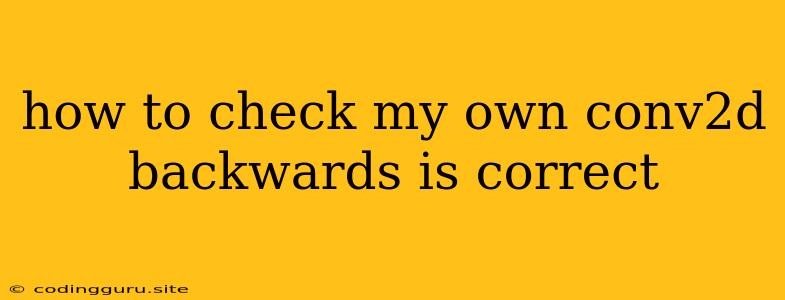How to Check Your Own Conv2D Backwards Implementation is Correct
Implementing the backward pass for convolutional neural networks (CNNs) can be tricky, and ensuring its correctness is crucial for training effective models. The convolutional layer, specifically the Conv2D operation, plays a vital role in CNNs. It's responsible for extracting features from input data, and understanding its backward pass is essential for optimizing the model's parameters.
This article will guide you through different methods and strategies to verify your custom Conv2D backward implementation.
Understanding the Conv2D Backward Pass
Before diving into verification methods, let's clarify the purpose of the Conv2D backward pass. During the backward pass, we aim to compute the gradients of the loss function with respect to the convolutional layer's weights, biases, and the input features. These gradients are then used to update the layer's parameters during optimization.
Key Components of the Conv2D Backward Pass:
- Gradient of Loss w.r.t. Weights: This gradient represents the contribution of each weight to the final loss.
- Gradient of Loss w.r.t. Biases: Similar to weights, this gradient measures the influence of biases on the loss.
- Gradient of Loss w.r.t. Input Features: This gradient is used to propagate the error information back through the network, enabling subsequent layers to adjust their parameters.
Verification Strategies
-
Numerical Differentiation:
- Concept: Numerical differentiation provides a straightforward approach to approximate the gradient of a function. It relies on calculating the difference between the function's output at two nearby input points.
- Implementation:
- Choose a small value for
h(e.g., 1e-5). - Calculate the function's output at
xandx + h. - Approximate the derivative using the formula:
(f(x + h) - f(x)) / h.
- Choose a small value for
- Benefits: Simple to implement and understand.
- Limitations: Prone to numerical instability and accuracy issues, especially for small
hvalues.
-
Analytical Verification:
- Concept: This method involves deriving the mathematical equations for the backward pass based on the
Conv2Dforward pass. You need to calculate the gradients of the loss function with respect to each parameter (weights, biases, and input features). - Implementation:
- Derive the mathematical equations for the backward pass using the chain rule and other calculus principles.
- Implement these equations in your code.
- Benefits: Offers high accuracy and a deeper understanding of the backward pass.
- Limitations: Requires extensive mathematical knowledge and can be complex.
- Concept: This method involves deriving the mathematical equations for the backward pass based on the
-
Comparison with Existing Libraries:
- Concept: Leverage established deep learning libraries like TensorFlow or PyTorch that provide highly optimized
Conv2Dimplementations with verified backward passes. - Implementation:
- Run your custom
Conv2Dbackward pass on a test input. - Execute the equivalent
Conv2Doperation using the chosen library. - Compare the calculated gradients from both implementations.
- Run your custom
- Benefits: Efficient and reliable for validating your implementation against a trusted source.
- Limitations: Requires familiarity with the chosen library's API and potentially more code.
- Concept: Leverage established deep learning libraries like TensorFlow or PyTorch that provide highly optimized
-
Unit Testing:
- Concept: Write dedicated unit tests to isolate and validate specific aspects of your
Conv2Dbackward implementation. - Implementation:
- Design test cases that cover different input shapes, kernel sizes, strides, paddings, etc.
- For each test case, compare the outputs of your implementation with a known-correct reference.
- Benefits: Enables systematic testing, helps identify potential errors, and promotes code maintainability.
- Limitations: Requires effort in designing and implementing tests.
- Concept: Write dedicated unit tests to isolate and validate specific aspects of your
Example: Numerical Differentiation (Python)
import numpy as np
def conv2d_forward(input, kernel, bias, stride, padding):
# ... Your forward pass implementation ...
def conv2d_backward_numerical(input, kernel, bias, stride, padding, dL_dout):
# ... Your backward pass implementation ...
def numerical_gradient(func, x, h=1e-5):
"""
Calculates the numerical gradient of a function.
Args:
func: The function to differentiate.
x: The input point.
h: Step size for numerical differentiation.
Returns:
The numerical gradient.
"""
return (func(x + h) - func(x)) / h
# Example usage:
input = np.random.randn(1, 3, 5, 5)
kernel = np.random.randn(2, 3, 3, 3)
bias = np.random.randn(2)
stride = 1
padding = 1
dL_dout = np.random.randn(1, 2, 4, 4)
# Compute gradients numerically
dkernel_numerical = numerical_gradient(lambda k: conv2d_forward(input, k, bias, stride, padding), kernel)
dbias_numerical = numerical_gradient(lambda b: conv2d_forward(input, kernel, b, stride, padding), bias)
dinput_numerical = numerical_gradient(lambda i: conv2d_forward(i, kernel, bias, stride, padding), input)
# Compute gradients using your backward pass implementation
dkernel, dbias, dinput = conv2d_backward_numerical(input, kernel, bias, stride, padding, dL_dout)
# Compare numerical and analytical gradients
print(f"dkernel difference: {np.linalg.norm(dkernel - dkernel_numerical)}")
print(f"dbias difference: {np.linalg.norm(dbias - dbias_numerical)}")
print(f"dinput difference: {np.linalg.norm(dinput - dinput_numerical)}")
Conclusion
Verifying your custom Conv2D backward implementation is essential to ensure that your neural network learns effectively. The methods discussed in this article, including numerical differentiation, analytical verification, comparison with existing libraries, and unit testing, provide different approaches to identify and address potential errors. Choose the methods that best suit your needs and level of comfort, and prioritize thorough testing to ensure the accuracy and robustness of your implementation.
